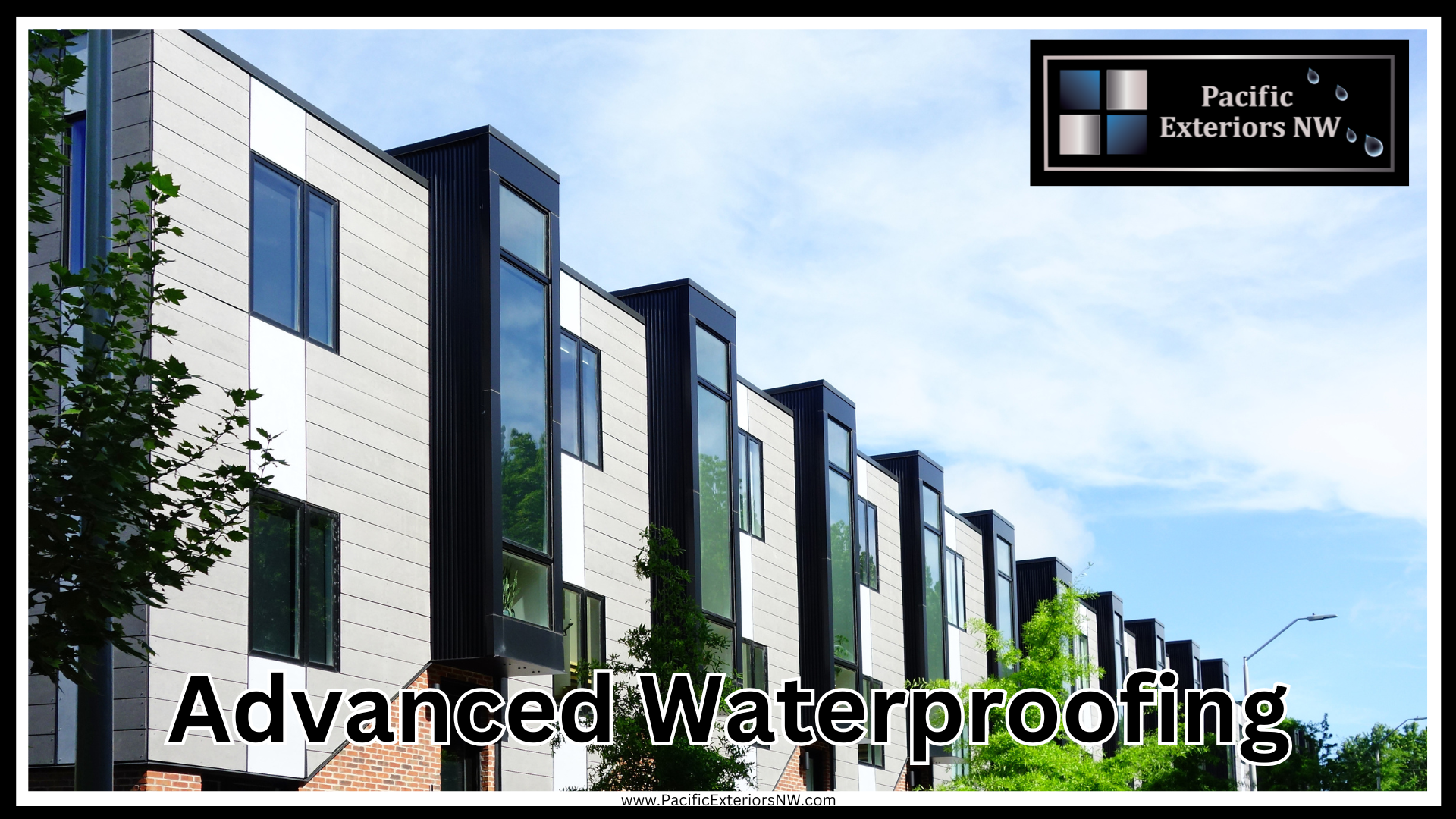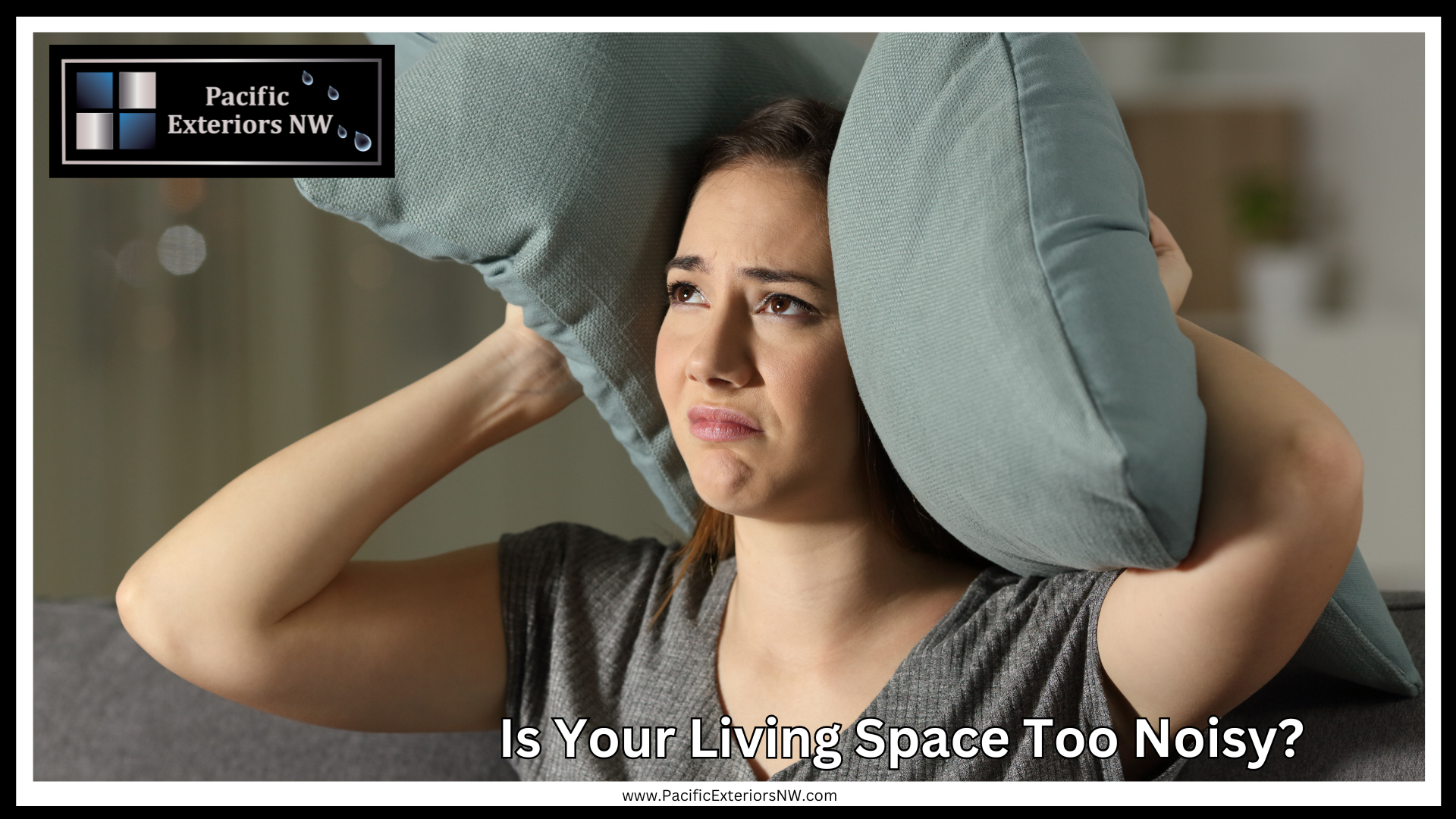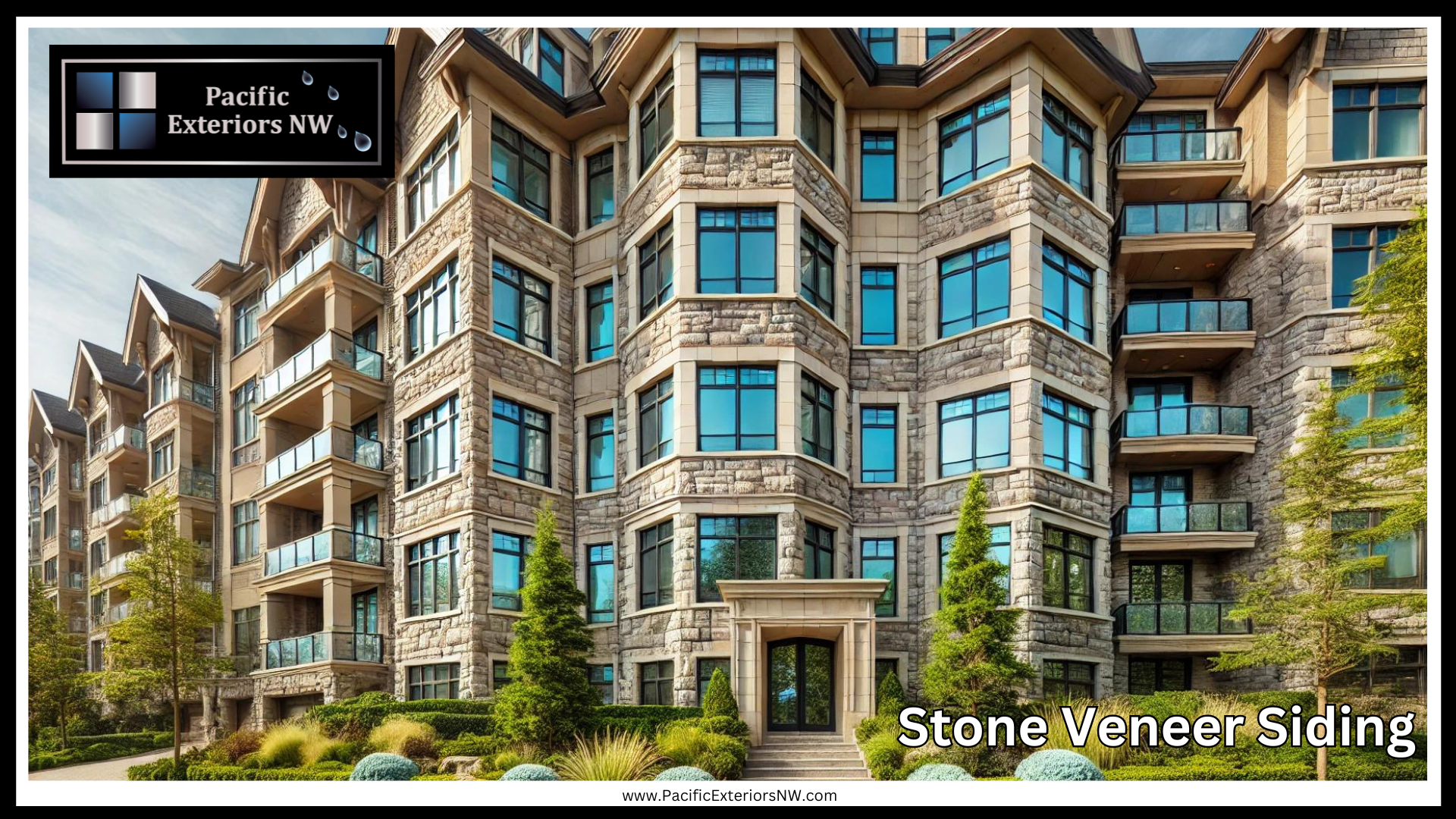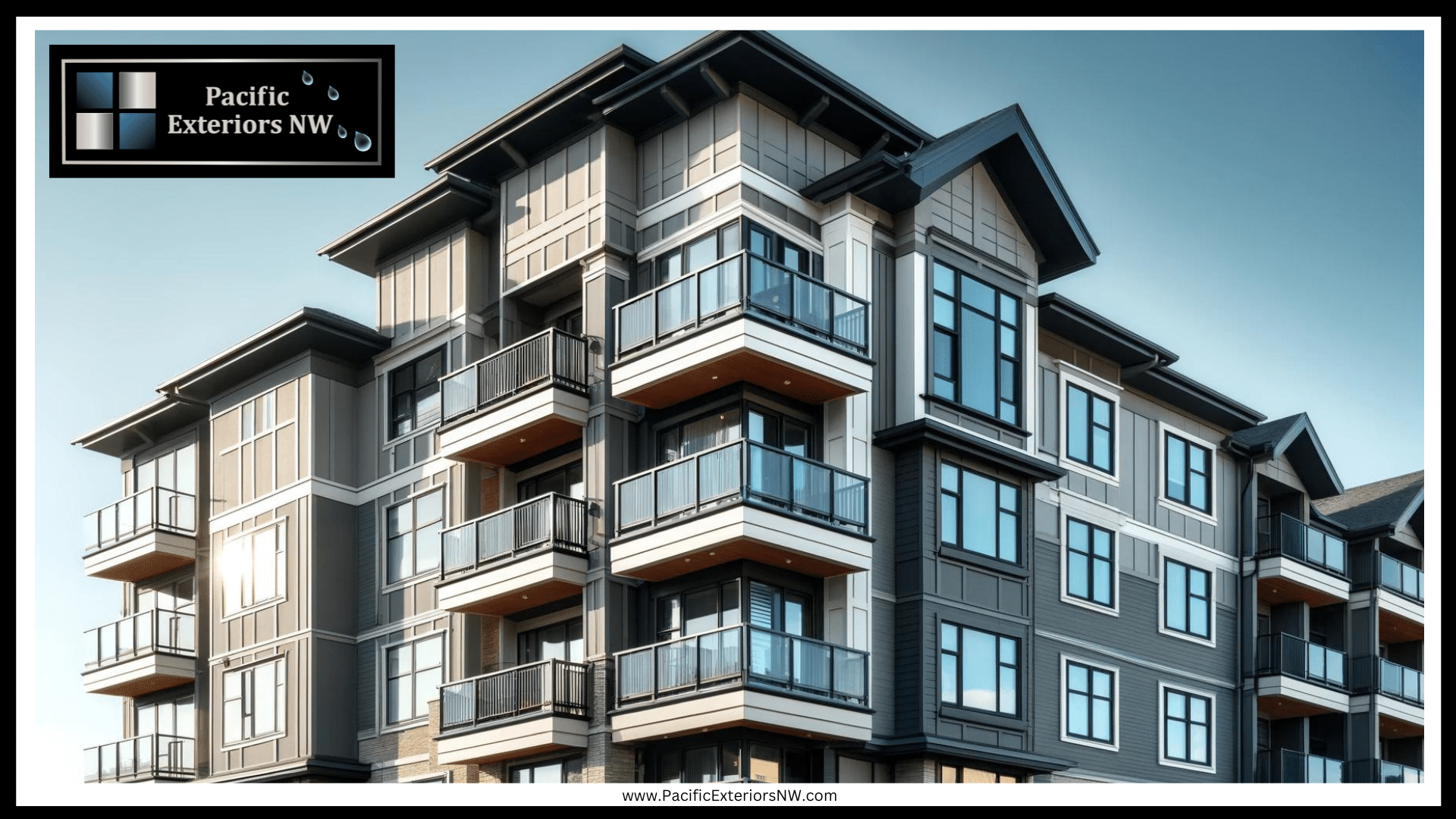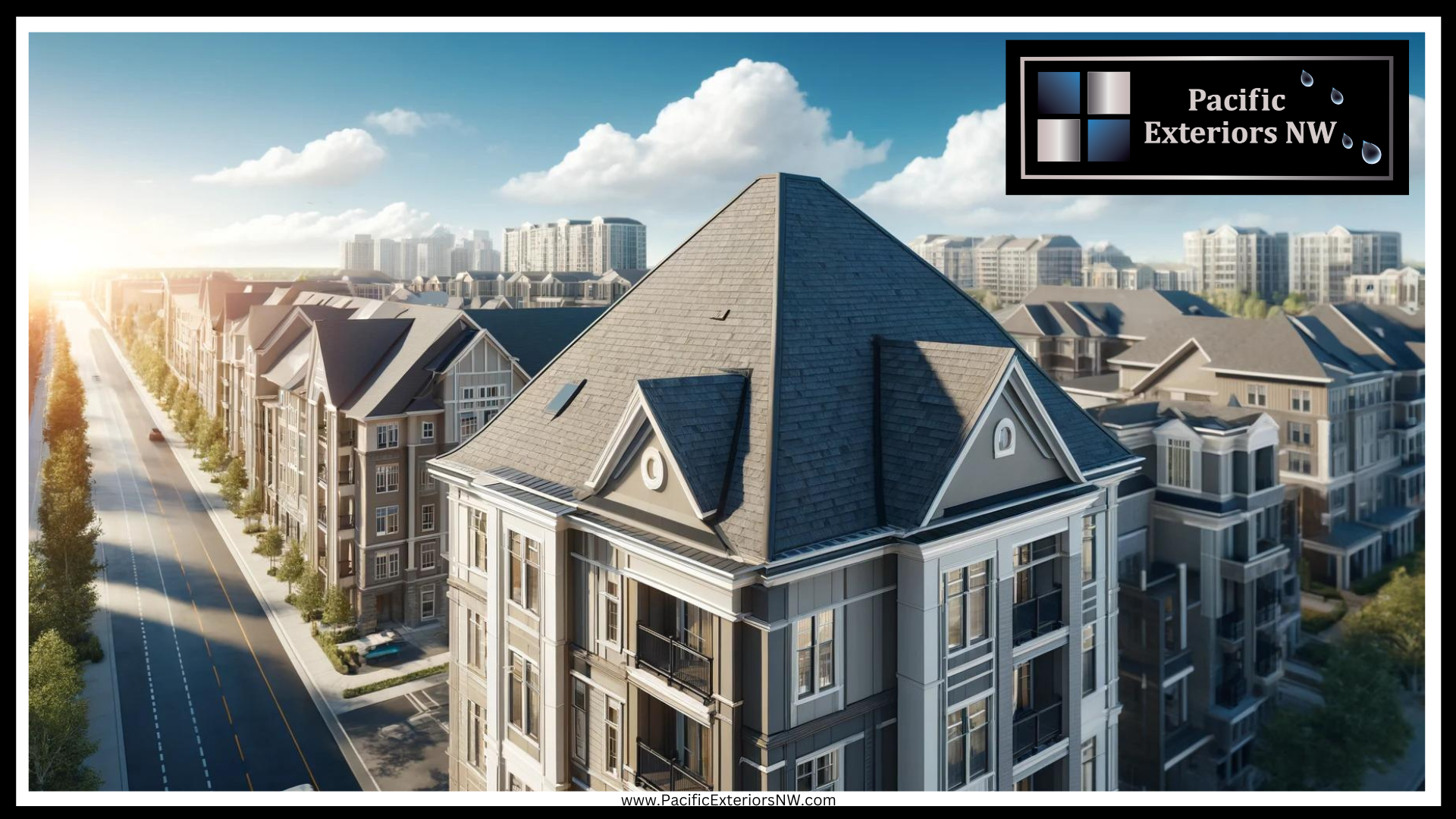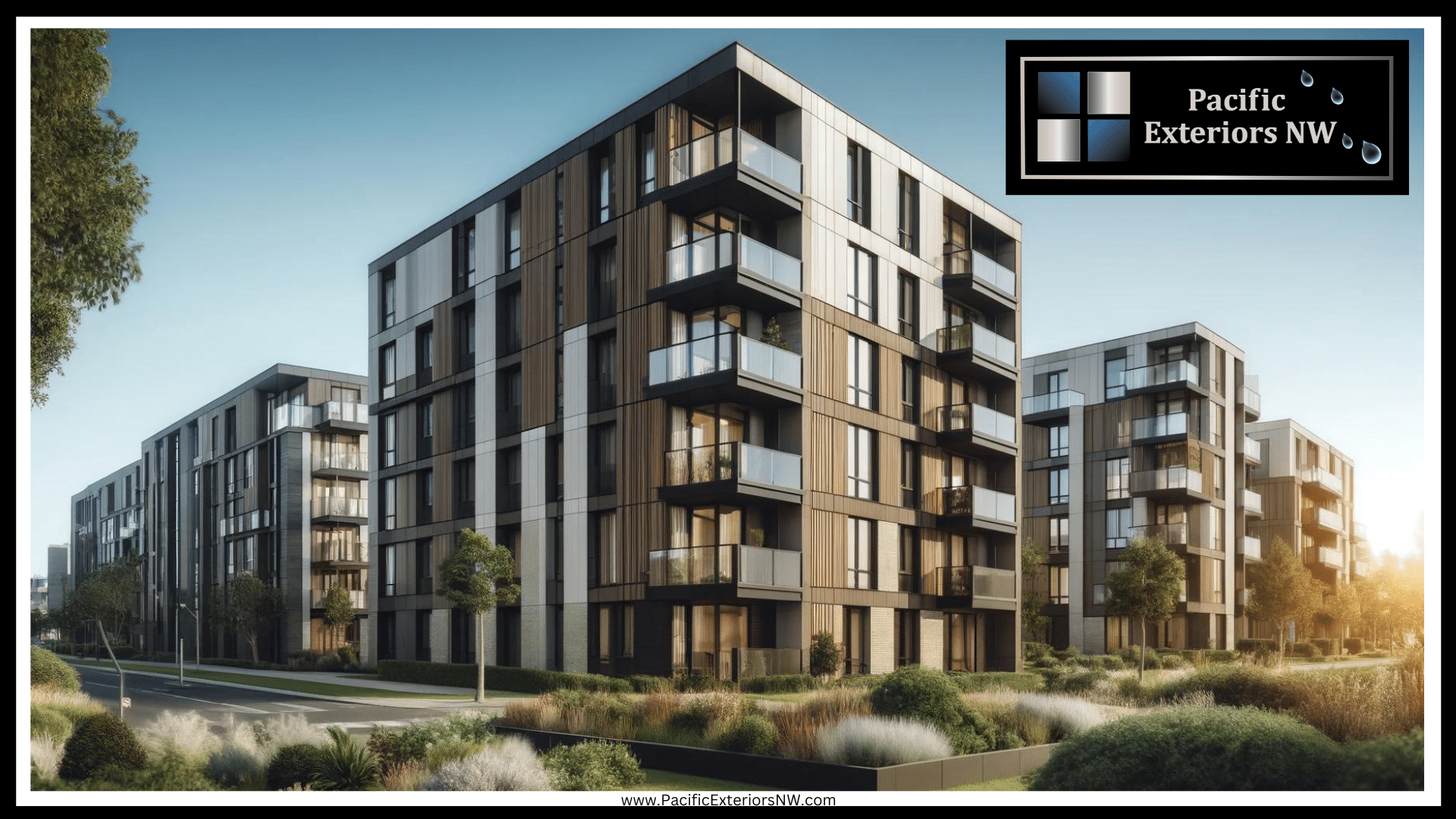
Innovative Siding Materials Shaping Multifamily Housing Trends
When it comes to multi-family housing, the materials used in siding and roofing define a property’s aesthetic appeal and contribute to its sustainability and maintenance costs. As the demand for innovative building solutions rises, Pacific Exteriors NW, a leader in the field, remains at the forefront, delivering cutting-edge materials that meet functional and environmental standards. This article explores the latest trends in siding and roofing materials transforming multi-family housing projects, showcasing Pacific Exteriors NW’s expertise and leadership.
Multifamily housing in Portland, Beaverton, Gresham, and surrounding areas is at a premium. Get a competitive edge for finding renters by maintaining a place they proudly call home.
Siding Materials
The choice of siding materials significantly impacts the longevity, energy efficiency, and appearance of buildings. Here, we discuss several materials that set trends in the multi-family housing sector.
Composite Siding: Durable Innovation for Multifamily Housing
Composite siding is increasingly popular in the multi-family housing market due to its durability and versatility. Pacific Exteriors NW has successfully integrated this material into numerous housing projects, valuing its numerous benefits and diverse applications. Here’s a closer look at the benefits of composite siding and its best usage in multi-family housing developments.
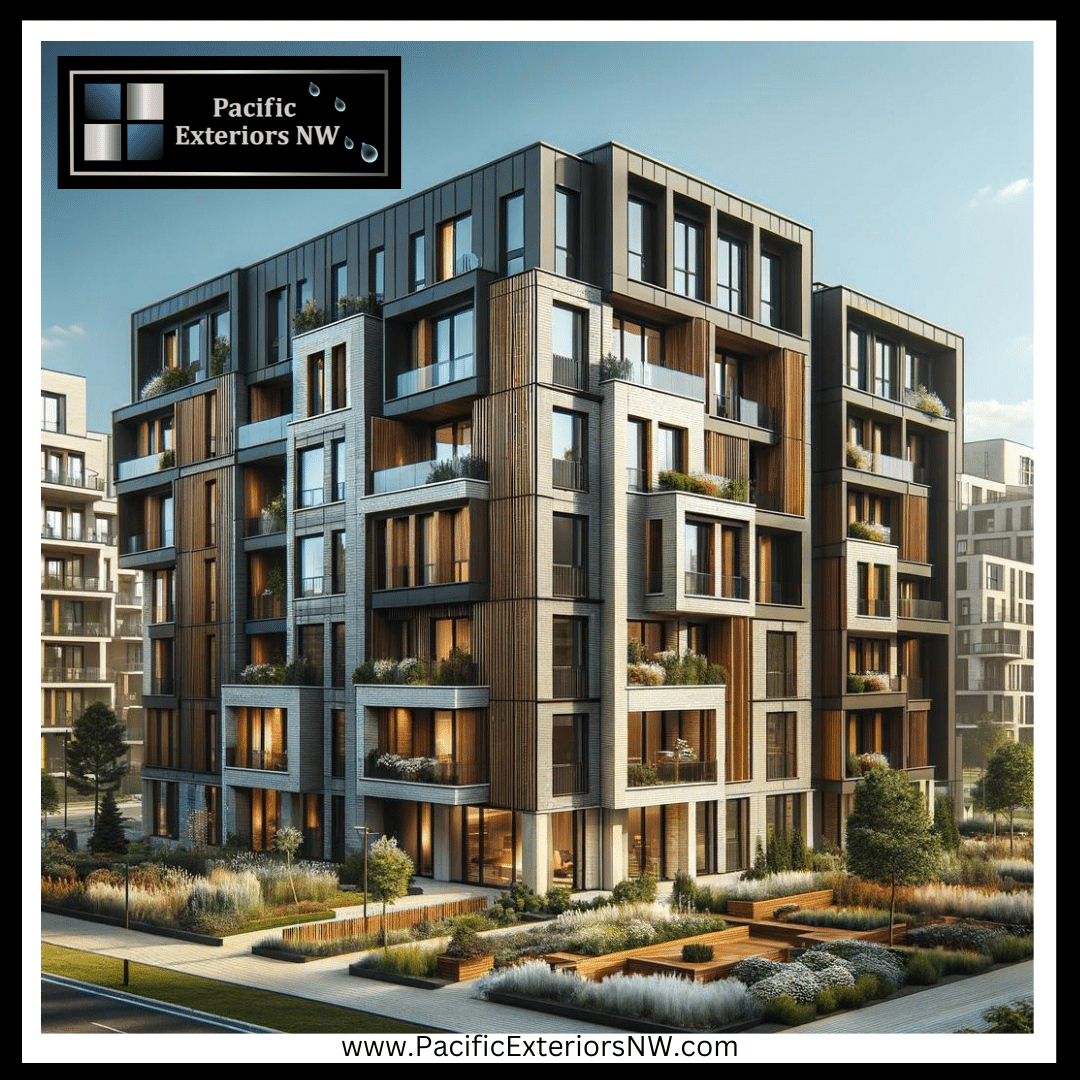
Benefits of Composite Siding
- Exceptional Durability: Composite siding is engineered to withstand severe weather conditions, including heavy winds, hail, and extreme temperatures. It resists warping, rotting, and cracking, common issues in less robust siding materials. This makes it an excellent choice for regions that experience diverse or harsh climates.
- Low Maintenance: Unlike traditional wood siding, composite siding does not require frequent painting or staining. Its color is baked in during manufacturing, which helps maintain its vibrant appearance without regular upkeep. This feature particularly appeals to property managers and tenants who prefer lower maintenance costs and effort.
- Aesthetic Flexibility: One of the most significant advantages of composite siding is its ability to mimic the appearance of natural wood, brick, or stone. This allows architects and designers to achieve various aesthetic goals without compromising on cost or material limitations. We utilize this flexibility to create unique, appealing exteriors that stand out in the housing market.
- Eco-Friendly: Many composite sidings are made from recycled materials, contributing to a more sustainable construction cycle. This aligns with the growing trend of green building practices, making it an attractive option for environmentally conscious developers and investors.
- Improved Energy Efficiency: Composite siding often includes insulative properties that help regulate indoor temperatures, leading to decreased energy usage for heating and cooling. This reduces utility costs and enhances residents’ comfort, an essential consideration in multifamily dwellings.
Best Usages of Composite Siding
- Urban Multi-Family Complexes: Composite siding is an excellent choice for bustling urban environments where aesthetic appeal and durability are key. It supports a modern look while offering the resilience needed to withstand the wear and tear of high-traffic areas.
- High-End Residential Developments: For luxury multi-family units, composite siding provides the upscale look of natural materials without the associated costs or maintenance challenges. Pacific Exteriors NW often recommends composite siding for premium projects to enhance curb appeal while ensuring long-term value.
- Eco-Friendly Projects: Composite siding is ideal for developments aiming to achieve LEED certification or other environmental standards due to its potential use of recycled materials and energy-efficient qualities. It supports the construction of green buildings without compromising on style or performance.
- Renovation Projects: When updating older multi-family buildings, composite siding is a cost-effective way to modernize exteriors and improve insulation without extensive structural changes. It can be easily installed over existing materials, which minimizes construction time and disruption to tenants.
- Coastal Properties: For properties in coastal areas, like the Washington or Oregon coast, composite siding’s moisture-resistant and durable nature makes it an optimal choice to withstand humid conditions and salt spray, reducing the risk of degradation over time.
By incorporating composite siding, Pacific Exteriors NW ensures that multi-family housing projects meet the aesthetic and functional needs of modern living and embrace sustainable practices. This innovative material continues to shape the future of residential developments, offering a practical yet sophisticated solution to contemporary housing challenges.
Fiber Cement Siding: Robust and Refined Solutions for Multifamily Housing
Fiber cement siding is a standout choice for multi-family housing, combining durability, beauty, and versatility. Pacific Exteriors NW recognizes the superior qualities of fiber cement siding, particularly those offered by the James Hardie brand, renowned for its premium products tailored to various climates and aesthetic preferences. Below, we explore the benefits of fiber cement siding and highlight the best use cases, focusing on James Hardie products. Fiber cement siding endures well here in the Portland, Beaverton, Gresham, and greater Metro areas.
Benefits of Fiber Cement Siding
- Outstanding Durability: Fiber cement siding is exceptionally resistant to the most common threats to siding materials, including fire, wind, rain, and termites. The composition of cement, sand, and cellulose fibers ensures it does not rot, buckle, or warp. James Hardie products, for example, undergo rigorous testing to ensure they can withstand severe weather conditions, making them a reliable choice for any region.
- Low Maintenance: Unlike wood, fiber cement siding does not need regular painting or sealing. For instance, James Hardie’s color technology provides a longer-lasting finish that resists fading from UV exposure, meaning the siding retains its vibrant color for years without frequent touch-ups.
- Aesthetic Versatility: James Hardie fiber cement siding comes in many styles and textures, from smooth, modern finishes to textures that mimic wood grain. This variety allows architects and developers to achieve a high-end look tailored to the property’s architectural style, whether contemporary, traditional, or entirely unique.
- Fire Resistance: Fiber cement siding is non-combustible. It won’t ignite when exposed to a direct flame, nor will it contribute fuel to a fire. This feature is particularly important in multi-family units where fire safety is paramount. James Hardie’s siding complies with strict fire safety standards, providing residents with additional security.
- Sustainability: James Hardie is committed to sustainable manufacturing processes, making its fiber cement products an excellent choice for eco-conscious projects. Fiber cement’s durability and low maintenance requirements also contribute to its sustainability, as it requires less frequent replacement and fewer resources for upkeep than other siding materials.
Best Usages of Fiber Cement Siding
- High-Density Residential Areas: In densely populated areas where fire risk might be heightened due to the proximity of buildings, the fire-resistant properties of James Hardie fiber cement siding offer an invaluable safety advantage.
- Regions with Harsh Weather: James Hardie’s HardieZone system is specifically designed to meet the weather demands of specific regions. Whether it’s the humid heat of the South, the freezing temperatures of the North, or the variable climates of the coastal areas, there’s a Hardie product engineered to perform.
- Architecturally Diverse Developments: James Hardie’s wide range of textures and finishes allow for distinct and diverse aesthetic expressions for developments aiming to stand out with unique architectural styles. We often employ this versatility to cater to upscale markets or specific design themes.
- Sustainable Building Projects: For projects aiming to achieve green building certifications like LEED, fiber cement siding is an optimal choice because of its durability and James Hardie’s commitment to sustainability. It reduces the environmental impact throughout the building’s life.
- Renovation and Retrofit Projects: Fiber cement siding is ideal for updating older buildings, as it can significantly improve exterior durability and appearance while enhancing the building’s fire safety and energy efficiency. James Hardie products’ superior longevity and aesthetic qualities make them particularly suitable for upscale renovations.
By integrating James Hardie fiber cement siding, Pacific Exteriors NW not only boosts the aesthetic appeal and safety of multi-family housing projects but also ensures long-term satisfaction and reduced maintenance costs. This makes fiber cement siding a smart investment for any multi-family housing developer looking to combine style with practical benefits.
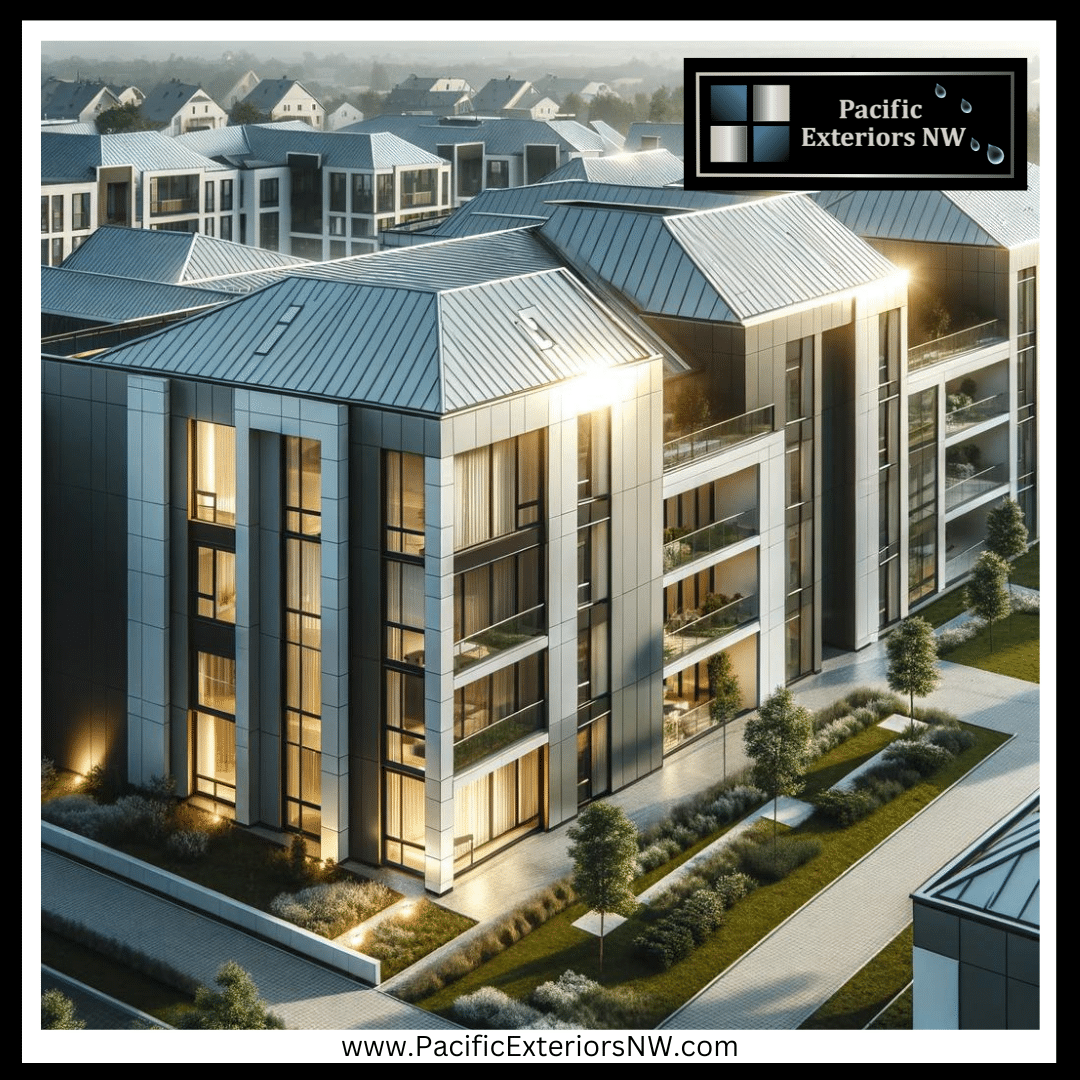
Roofing Materials for Multifamily Dwellings
Roofing materials are critical in multi-family housing projects’ overall functionality, energy efficiency, and aesthetic appeal. Pacific Exteriors NW leverages a variety of innovative roofing options to meet diverse needs. Here’s an expanded look at each roofing material, emphasizing their specific benefits and best applications in multi-family housing.
Metal Roofing: Durable and Reflective
Benefits:
- Longevity: Metal roofs can last up to 50 years or more with minimal maintenance, making them ideal for long-term investments.
- Fire Resistance: Metal roofing is non-combustible, offering an added layer of safety in multi-family housing.
- Energy Efficiency: Metal roofs’ reflective properties reduce cooling costs by reflecting solar radiant heat away from the building.
Best Usages:
- High-Wind Regions: Metal roofs are excellent for areas prone to severe weather, as they can withstand high winds and are impervious to rain and snow.
- Modern Architectural Designs: Metal roofs provide a sleek, contemporary look, making them well-suited for buildings with a modern aesthetic.
- Retrofit Projects: Lightweight metal roofing can be installed over existing roofs, making it ideal for renovation projects without structural modifications.
Synthetic Roofing: Engineered for Performance
Benefits:
- Aesthetic Variety: Synthetic roofing materials are manufactured to mimic the look of slate, tile, or wood shakes, offering aesthetic flexibility.
- Impact Resistance: High durability against environmental impacts, including hail, wind, and decay.
- Weight Advantage: Lighter than natural materials, synthetic roofing does not require additional structural support.
Best Usages:
- Heritage Properties: These are suitable for multi-family housing that aims to maintain a traditional aesthetic without the maintenance challenges of natural materials.
- Areas with Varied Weather Conditions: Effective in regions experiencing frequent environmental changes, providing consistent protection year-round.
- Budget-Conscious Developments: These offer the look of premium materials at a fraction of the cost, making them accessible for budget-sensitive projects.
By incorporating these innovative roofing materials into their projects, Pacific Exteriors NW enhances the functionality and sustainability of multi-family housing and contributes to its aesthetic and environmental value, creating comfortable, energy-efficient, and visually appealing homes for residents.
Why Pacific Exteriors NW?
As multifamily housing continues to evolve, the importance of selecting suitable materials cannot be overstated. Pacific Exteriors NW is dedicated to providing top-tier siding and roofing solutions that meet the needs of modern housing developments. Their extensive experience and commitment to quality ensure that every project meets and exceeds the expectations of developers and residents alike. By embracing innovative materials and technologies, Pacific Exteriors NW enhances multi-family buildings’ functionality and aesthetic appeal, making them more attractive, durable, and energy-efficient.
For HOA managers and multifamily building owners looking to capitalize on the latest trends and technologies in siding and roofing, reaching out to Pacific Exteriors NW is the first step towards creating a standout property that is attractive, sustainable, and strategically beneficial.
Serving all of Greater Portland Metro Area in Oregon
Multnomah County
97019 (Corbett)
97024 (Fairview)
97030 (Gresham)
97080 (Gresham)
97201 (Portland)
97202 (Portland)
97203 (Portland)
97204 (Portland)
97205 (Portland)
97206 (Portland)
97208 (Portland)
97209 (Portland)
Washington County
97006 (Aloha)
97007 (Aloha)
97106 (Banks)
97008 (Beaverton)
97005 (Beaverton)
97229 (Bethany)
97109 (Buxton)
97113 (Cornelius)
97116 (Forest Grove)
97117 (Gales Creek)
97119 (Gaston)
97123 (Hillsboro)
97124 (Hillsboro)
97125 (Manning)
97133 (North Plains)
97140 (Sherwood)
97223 (Tigard)
97224 (Tigard)
97144 (Timber)
97062 (Tualatin)
97225 (West Haven-Sylvan)
Clackamas County
97004 (Beavercreek)
97009 (Boring)
97013 (Canby)
97015 (Clackamas)
97017 (Colton)
97089 (Damascus)
97022 (Eagle Creek)
97023 (Estacada)
97027 (Gladstone)
97028 (Government Camp)
97086 (Happy Valley)
97034 (Lake Oswego)
97035 (Lake Oswego)
97222 (Milwaukie)
97038 (Molalla)
97067 (Mount Hood Village)
97011 (Mount Hood Village)
97049 (Mount Hood Village)
97042 (Mulino)
97267 (Oak Grove)
97045 (Oregon City)
97055 (Sandy)
97068 (West Linn)
97070 (Wilsonville)
Marion County
97325 (Aumsville)
97002 (Aurora)
97342 (Detroit)
97020 (Donald)
97317 (Four Corners)
97346 (Gates)
97026 (Gervais)
97305 (Hayesville)
97032 (Hubbard)
97350 (Idanha)
97352 (Jefferson)
97303 (Keizer)
97384 (Mehama)
97362 (Mount Angel)
97373 (Saint Benedict)
97137 (Saint Paul)
97301 (Salem)
97302 (Salem)
97306 (Salem)
97375 (Scotts Mills)
97381 (Silverton)
97383 (Stayton)
97385 (Sublimity)
97392 (Turner)
97071 (Woodburn)
Columbia County
97016 (Clatskanie)
97018 (Columbia City)
97054 (Deer Island)
97048 (Rainier)
97056 (Scappoose)
97051 (St. Helens)
97064 (Vernonia)
97053 (Warren)
Yamhill County
97101 (Amity)
97111 (Carlton)
97114 (Dayton)
97115 (Dundee)
97127 (Lafayette)
97128 (McMinnville)
97132 (Newberg)
97378 (Sheridan)
97396 (Willamina)
97148 (Yamhill)



